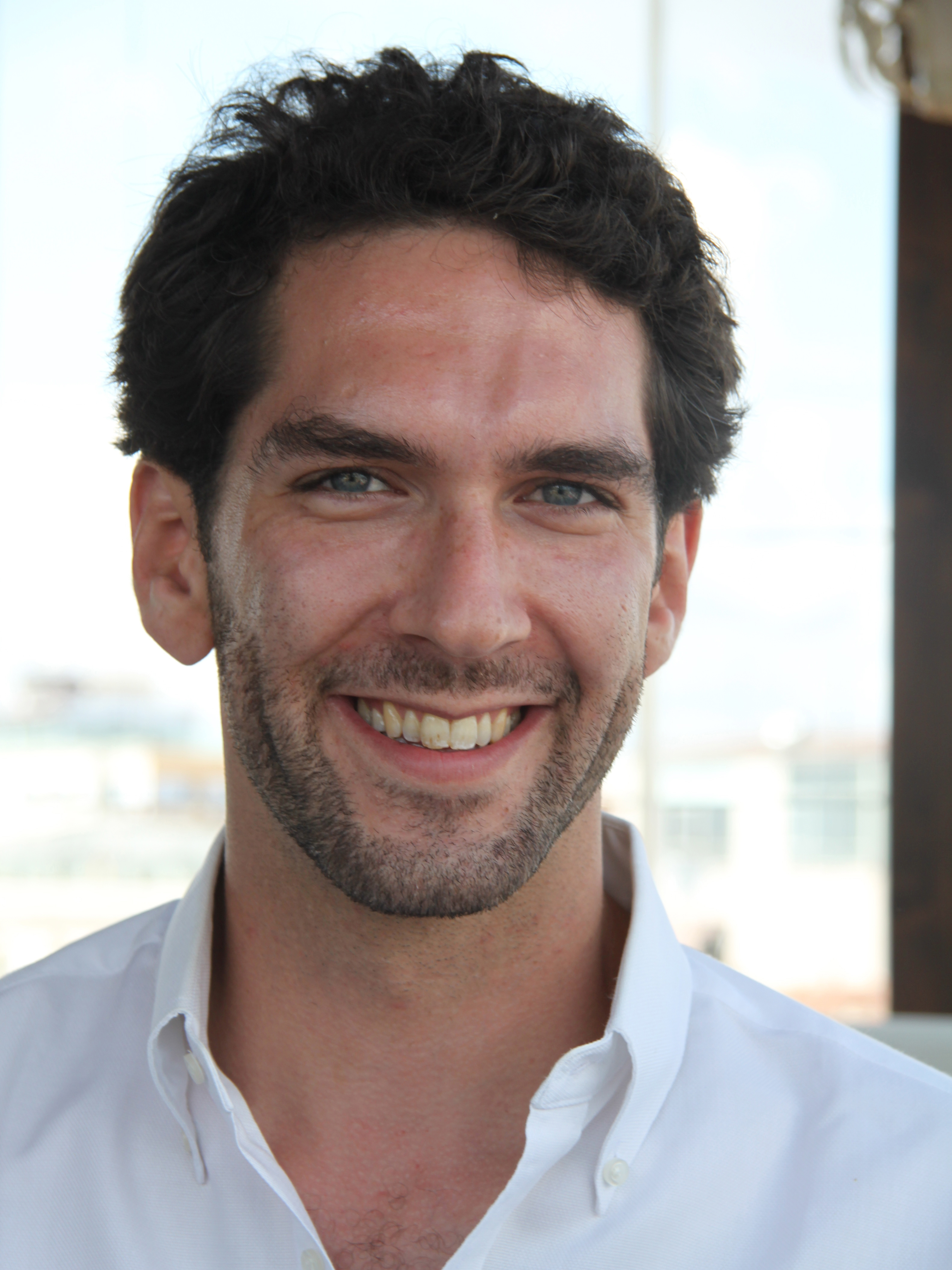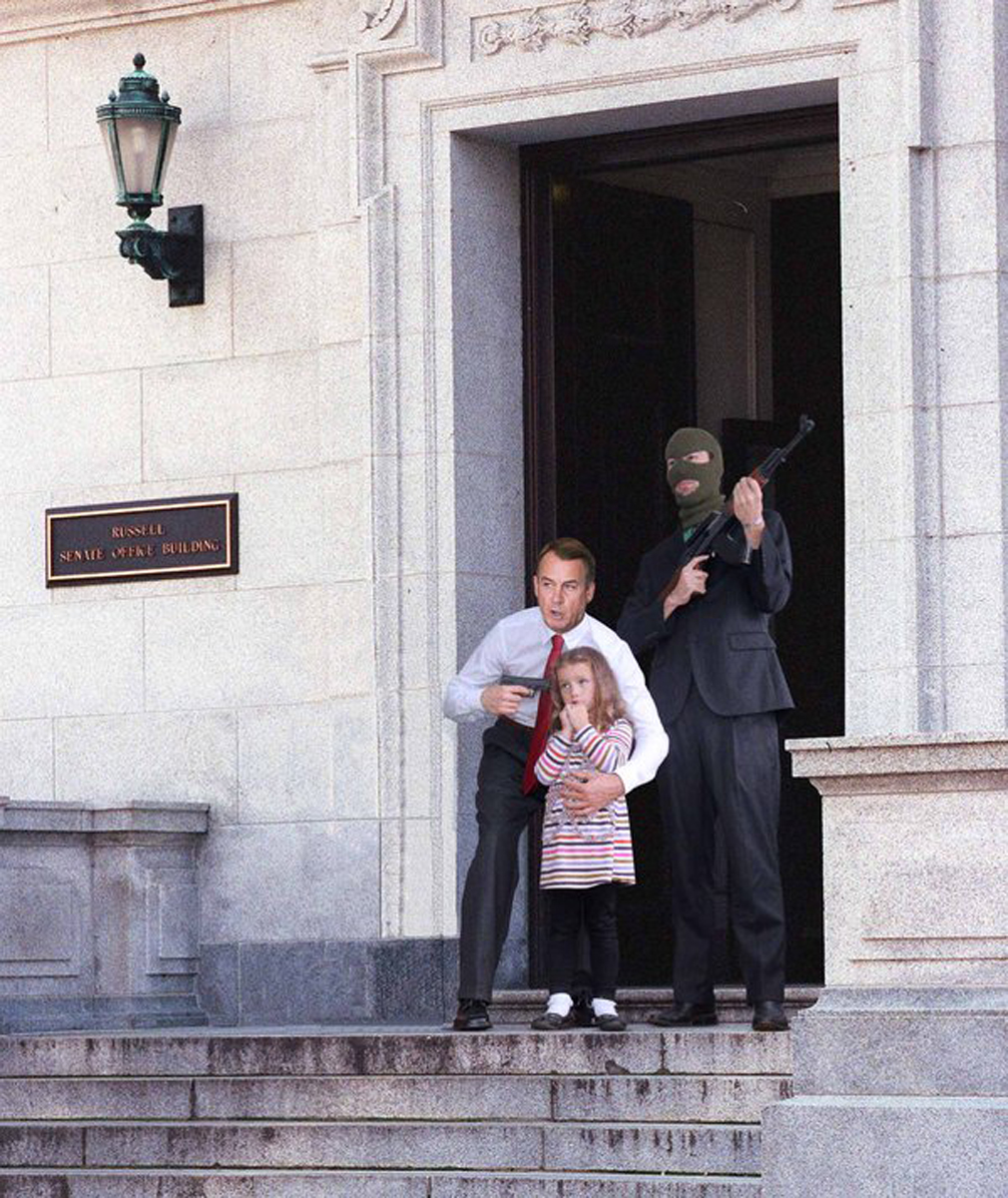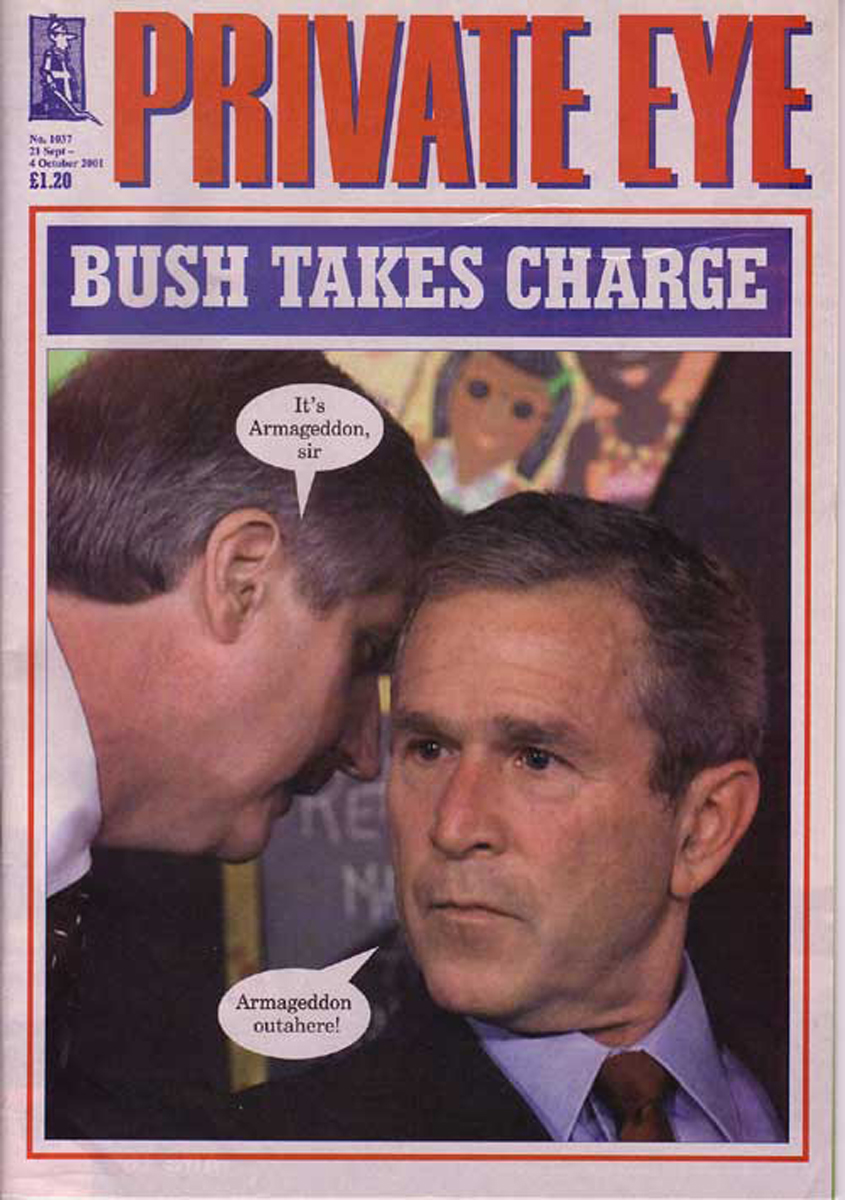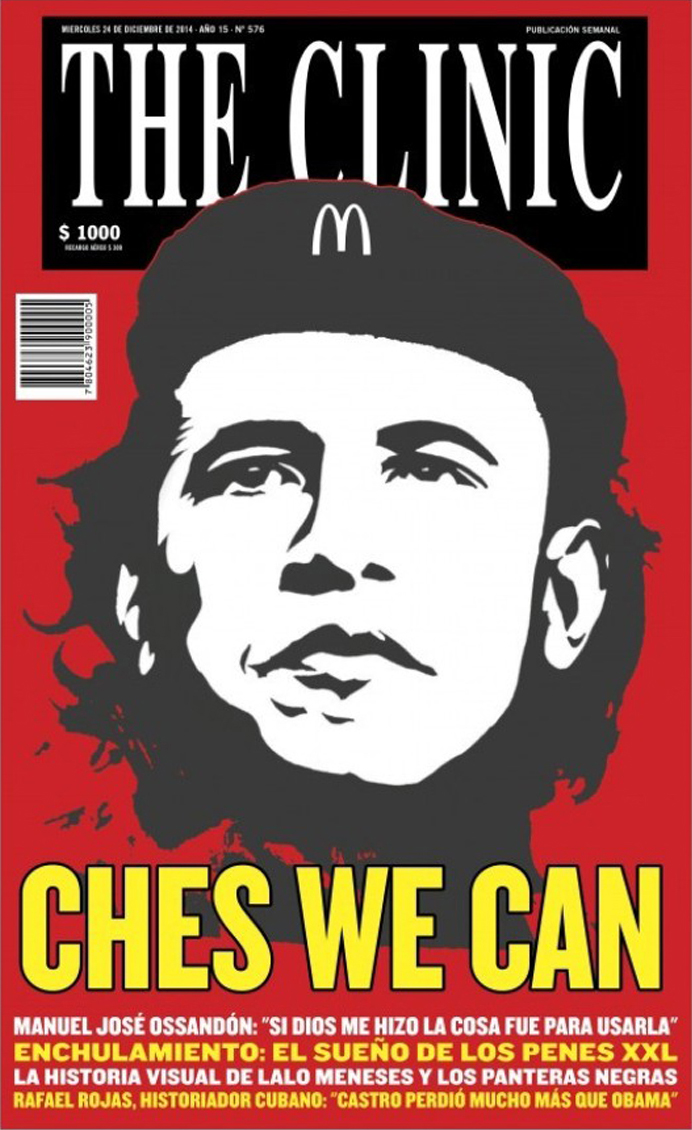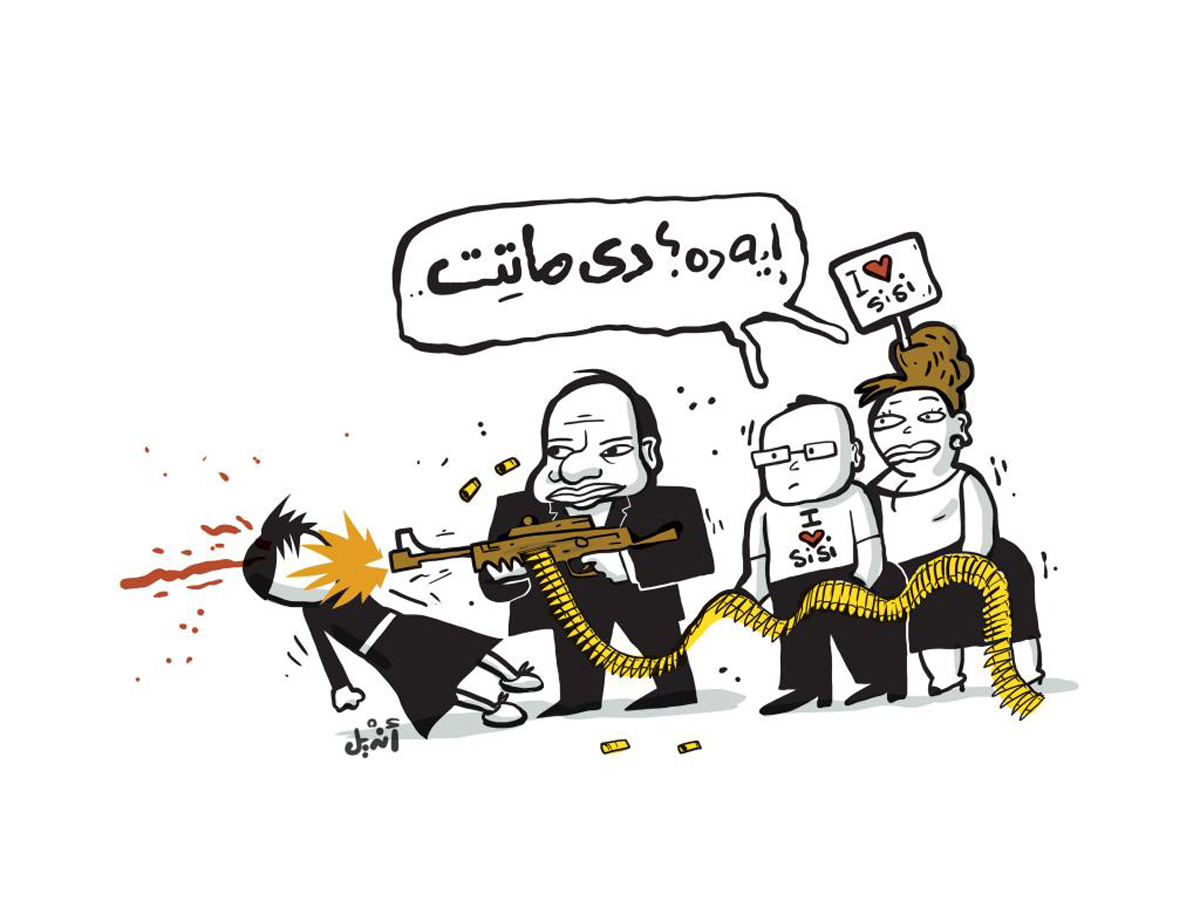
Philadelphia Daily News cartoonist Signe Wilkinson offered a multiple-choice test in 2010
The Palestinian newspaper Al-Hayat al-Jadida published the drawing in February. The next day Palestinian Authority President Mahmoud Abbas ordered an investigation into the image and its creator, Muhammad Sabaaneh. Abbas, who after the Charlie Hebdo attacks three weeks earlier had joined world leaders in a march against terrorism and in support of free speech in Paris, described the cartoon’s publication as “a terrible mistake” and stressed that “sacred religious symbols, especially the prophets and messengers” should be respected.
Palestinian Authority police questioned Sabaaneh, who apologized for the drawing and explained on Facebook that despite the title the robed figure was not intended to be a depiction of Muhammad, forbidden by Islamic authorities, but “a symbolic figure for Islam and the Muslim’s role in spreading light and love for all humanity.” Al-Hayat al-Jadida launched an inquiry, too, briefly suspending Sabaanah and other staff involved in the cartoon’s publication, and issued its own apology.
Sabaanah, whose satirical illustrations have criticized everything from Palestinian political parties to the Israeli occupation, had been in trouble before. In 2013, Israeli authorities sentenced him to five months in prison because one of his cartoons appeared in a book published by his brother, Thamer Sabaaneh, a member of Hamas, the Palestinian resistance movement governing Gaza that Israel considers a terrorist organization. A few years earlier he received a series of death threats from Hamas members, because of his caricatures of Hamas senior political leader Ismail Haniyeh.
“We should oppose everything that is forced on us, by governments or dictatorships or the authority of religion,” says Sabaanah. And as for respecting religious symbols, Sabaanah claims that’s exactly what his cartoon was intended to do: “The way to defend Islam is through art. When Islam is criticized through art, we should respond through art.”
In the post-Charlie Hebdo era, political cartooning remains a complex and contested pursuit
Sabaanah’s experience illustrates just how complex and contested political cartooning remains after brothers Said and Chérif Kouachi killed 12 at the offices of French satirical magazine Charlie Hebdo on January 7. The Paris attacks brought fresh urgency to longstanding questions around the limits of free speech, the role of satire as a form of dissent, and the relationship between political cartooning and journalism.
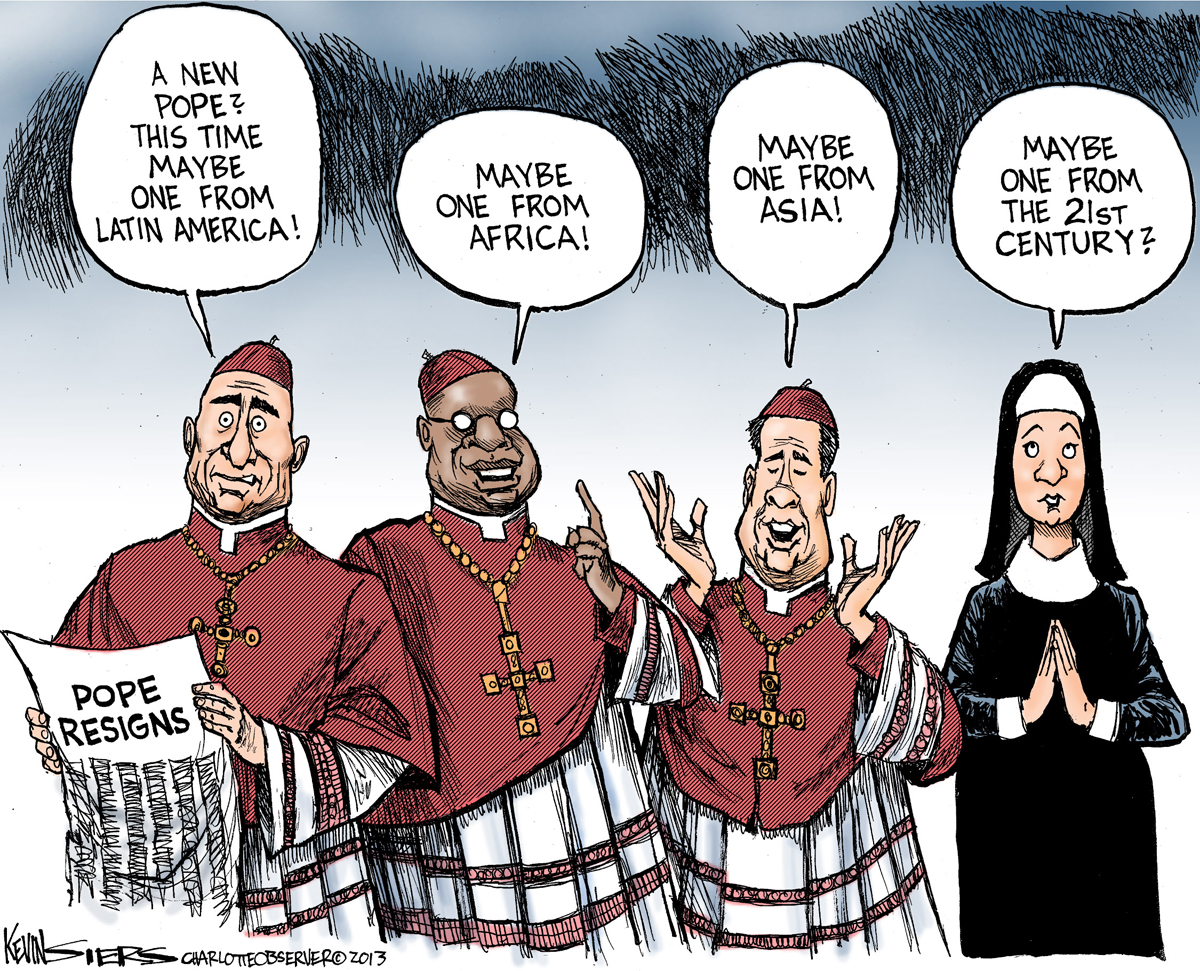
In 2013, when the pope stepped down, Kevin Siers of The Charlotte (N.C.) Observer mused on possible replacements
The Charlie Hebdo murders, and an attack aimed at Swedish cartoonist Lars Vilks, who had drawn images of the Prophet Muhammad many Muslims considered offensive, a month later in Copenhagen, focused attention on the threat to Western satirists. But political cartoonists around the world are at risk.
In Turkey in 2014, Recep Tayyip Erdogan, who was then prime minister, brought a criminal complaint against cartoonist Musa Kart, who in the midst of a corruption investigation into Erdogan’s inner circle depicted a hologram of Erdogan standing watch as thieves stole money from a safe. Lawyers sought nine years imprisonment; Kart was acquitted but Erdogan has appealed. In Ecuador, one of the best-known cartoonists in Latin America, Javier Bonilla, whose pen name is Bonil, is accused of “socioeconomic discrimination” for mocking the stutter and questioning the suitability for office of Agustin Delgado, a congressman from President Rafael Correa’s ruling party. In Singapore, the government charged Leslie Chew with sedition for the cartoonist’s criticism of state discrimination against ethnic minorities in his strip “Demon-Cratic Singapore.” And in Malaysia, Prime Minister Najib Razak’s government also accused cartoonist Zulkiflee Anwar Haque, known as Zunar, of sedition, for a cartoon criticizing a corrupt judiciary. “He points out corruption,” says John A. Lent, editor in chief of the International Journal of Comic Art, of Zunar. “He’s what a political cartoonist is supposed to be: a watchdog on government.”
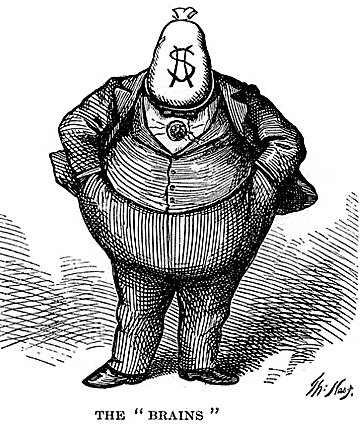
In 1871, Thomas Nast’s drawing of “Boss” Tweed fueled outrage over corruption
Tweed’s furious plea—“Stop them damned pictures. I don’t care so much what the papers say about me. My constituents can’t read. But, damn it, they can see pictures!”—may be apocryphal but it nonetheless aptly describes the task of the political cartoonist. “Our job is to create either some doubt in your mind about an issue or create a discussion,” says Christopher Weyant, a cartoonist whose work has appeared in The New Yorker, The Hill, and on the cover of the latest issue of Nieman Reports. “We want you to think. We want you to react.”
Reactions provoked by the Charlie Hebdo attack come at a time when satirists are increasingly seen as sources of news, especially by young people. A 2012 Pew survey found that about 80 percent of “The Daily Show” and “The Colbert Report” viewers were aged 18 to 49, compared to only 40 percent of network evening news viewers. Twelve percent of adults surveyed by Pew in 2014 said they received news from “The Daily Show” in the previous week, putting it on a par with USA Today and The New York Times. Another 2014 study, this one by the University of Delaware, showed that viewers of the “The Daily Show,” “The Colbert Report,” and John Oliver’s “Last Week Tonight” were much more familiar with net neutrality laws than viewers of mainstream networks.
The icons of American political satire—Jon Stewart and Stephen Colbert—may be moving on, but new satirists and satirical outlets are appearing to take their place. John Oliver’s show, “Last Week Tonight,” has stormed HBO as well as YouTube, where his channel boasts nearly 1.5 million subscribers. The Huffington Post is launching “The HuffPost Show,” a weekly Web-only satirical news program that will stream online in prime time. In the U.K., satirical puppet show “Newzoids” is being viewed as a successor to the classic ’80s program “Spitting Image,” which skewered the Margaret Thatcher government.Related Article
Bassem Youssef: The Joke Is Mightier than the Sword And the Web is creating new spaces for the distribution and debate of political cartoons. “The fact that comedians are becoming main sources of news only tells you what a failure our media outlets are,” says Bassem Youssef, who last June discontinued the satirical Egyptian TV show he hosted as tolerance for dissent in the country shrank.
In many countries in the Middle East, tolerance for satire has decreased since the upheavals of the Arab Spring. Consider the case of Syria’s Ali Ferzat, one of the Arab world’s most prominent political cartoonists. For decades, the Hafez al-Assad regime tolerated his veiled visual barbs, published in the state-run newspaper Tishreen. After al-Assad’s son Bashar took power in 2000, Ferzat launched the satirical newspaper al-Domari. But in 2011, the first year of the Syrian uprising, members of the regime’s masked security forces kidnapped and beat Ferzat, dumping him on the road to the airport with two broken hands. Ferzat’s colleague, Syrian cartoonist An earlier version of this piece misspelled the name of the cartoonist missing in Syria. It is Akram Raslan.Akram Raslan, has been missing for nearly two years. “I survived an assassination attempt,” says Ferzat, who just days before his abduction drew a caricature of a lanky Assad hitching a ride with Libyan autocrat Muammar el-Qaddafi, “so freedom does not come for free.”
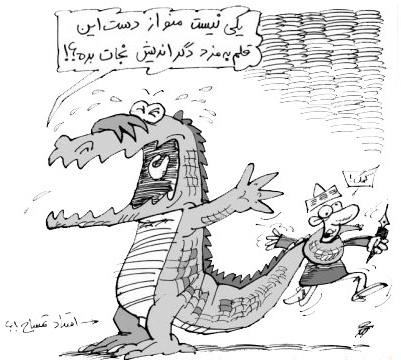
In Iran in 2000, Nikahang Kowsar’s drawing of a crocodile strangling a journalist raised a furor
For Ferzat, the price of freedom has been exile. He now lives in Kuwait, where he draws for the pan-Arab daily Al-Quds Al-Arabi. Iranian cartoonist Nikahang Kowsar has also opted to work outside his home country. Back in 2000, Kowsar drew a cartoon of a crocodile choking a reporter with its tail. In Farsi, “Professor Crocodile,” as the reptile was labeled, rhymes with the nickname of Ayatollah Muhammad Taqi Mesbah Yazdi, then one of the country’s top clerics. Kowsar ended up spending six days in Tehran’s notorious Evin Prison and was charged with insulting a religious figure and undermining national security. In Iran, Kowsar says, “We have freedom of speech; we don’t have freedom after speech. You are free to draw a cartoon, but you are arrested the next day if they don’t like your cartoon.”
The intimidation continued: Kowsar’s phone was tapped, his e-mail hacked. Subsequent death threats pushed him to Canada and then to Washington, D.C. After leaving Iran, he founded Toonistan.com, a cartoon-oriented social media platform, and Khodnevis, an alternative Farsi news source that prominently features cartoons. Kowsar notes that, despite the risks, political cartooning is alive and well in Iran, with more illustrators addressing touchier subjects, like poverty and water shortages, largely online.
Ahmed Benchemsi, a native Moroccan who founded and edited the best-selling Arabic news weekly Nichane, has followed a similar path. Benchemsi left Morocco after advertiser boycotts depleted the magazine’s finances. He now edits and publishes Free Arabs, an online outlet he co-founded in 2012, while at Stanford University. Free Arabs has featured over 500 bloggers, including an array of secular and progressive voices from the Middle East, and gives pride of place to political art and satire. It also produces “The Fatwa Show,” a Web video series lampooning Islamic clerics, and “The Horrific 4,” a collection of sardonic columns mocking fears around taboo topics like “the Jew,” “the Atheist,” and “the Independent Woman.” “The first thing to do if we want the Arab World to go forward is to look at ourselves in the mirror and criticize what deserves to be criticized,” says Benchemsi.
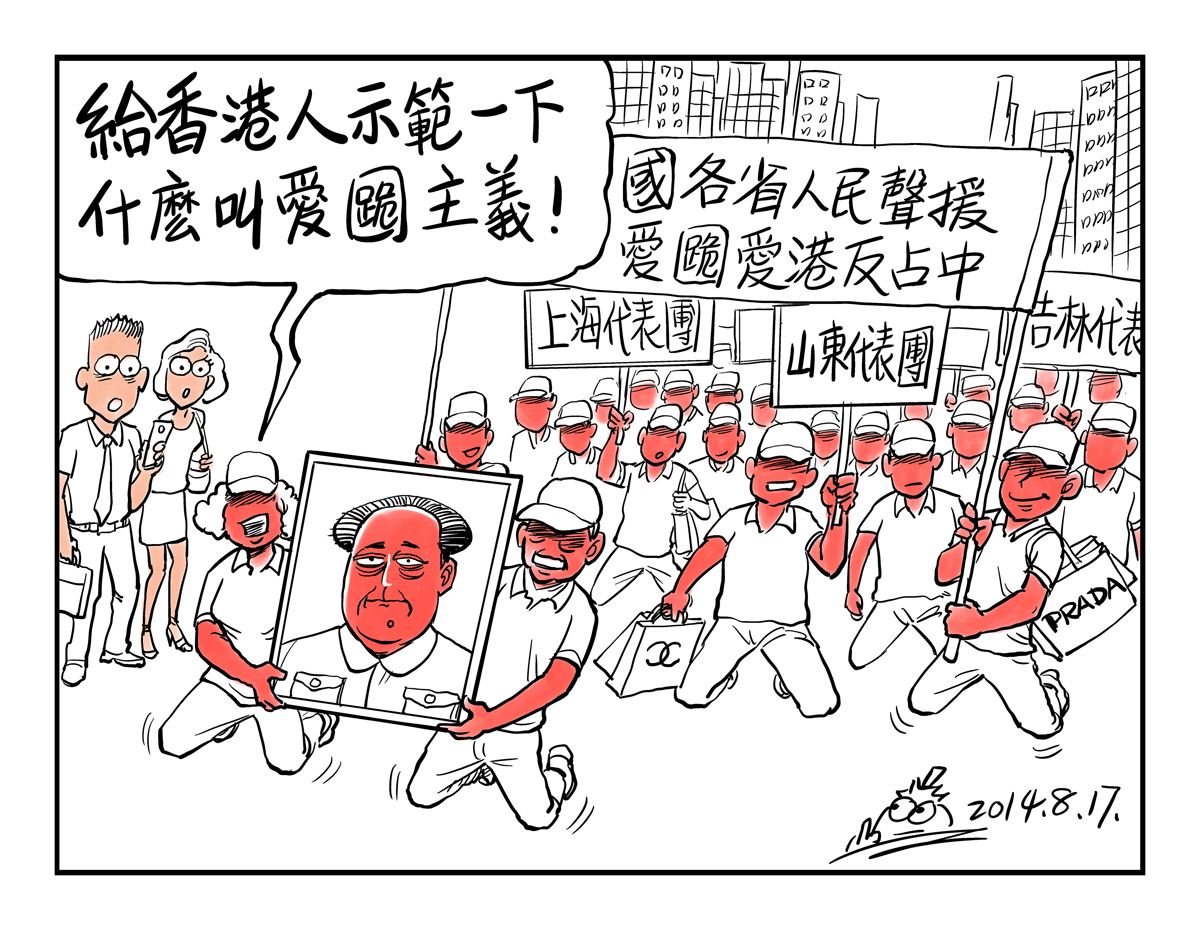
In August, Chinese cartoonist Wang Liming lampooned pro-Beijing protesters in Hong Kong
While in Japan last summer, he mocked the mainland government for busing in demonstrators to a counter-protest against the democracy marches then taking place in Hong Kong. He shared a cartoon of red-faced Chinese citizens—all dressed the same, some holding Chanel and Prada shopping bags—walking on their knees; a woman holding a portrait of Mao yells, “Let’s show Hong Kongers what it means to kneel for your country.”
A website linked to the Communist Party newspaper The People’s Daily and its sister publication Global Times, as well as other outlets, labeled Wang a “pro-Japan traitor,” and a fresh batch of his microblog accounts was shut down. Fearing for his safety, Wang decided to remain in Japan, where he continues to draw cartoons and share them online. “I decided to throw away self-censorship,” he says of his decision not to return to China. “It is such a wonderful feeling that I can create cartoons freely.”
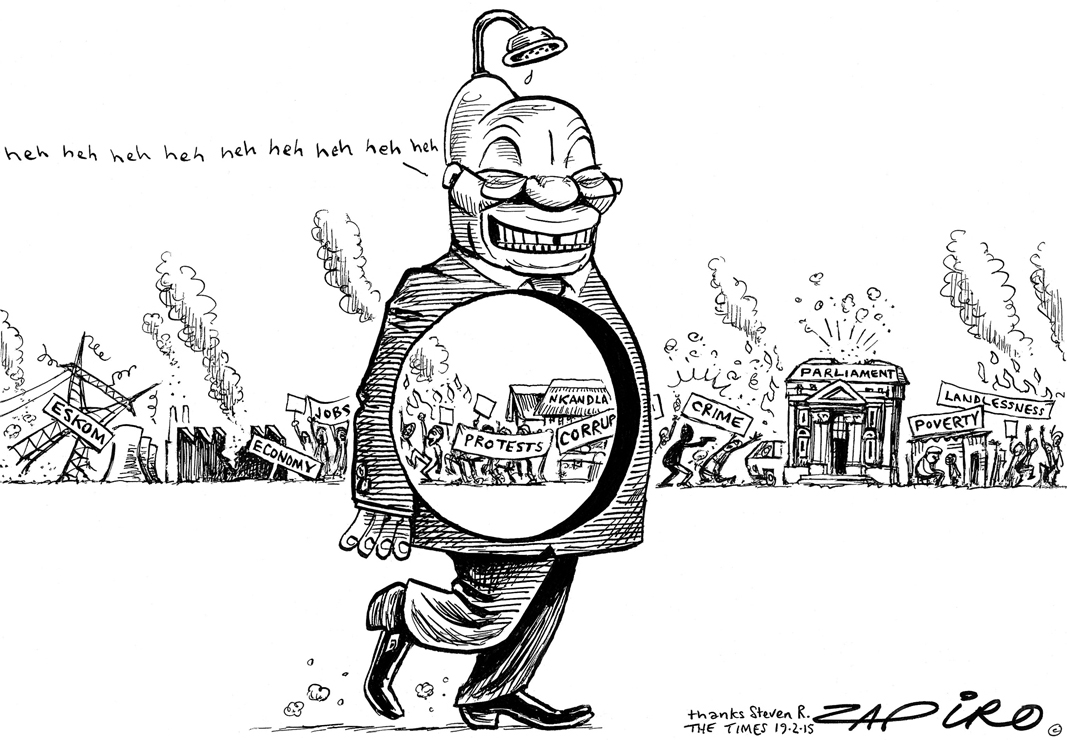
In Jonathan Shapiro’s 2015 cartoon, South Africa’s leader kept smiling despite the nation’s woes
South African cartoonist Jonathan Shapiro, better known as Zapiro, has decided to stay put, despite death threats he received for a 2010 cartoon depicting the Prophet Muhammad on a psychiatrist’s couch saying, “Other prophets have followers with a sense of humor!” Tolerance for satire is a pretty good indicator of the general health of a democracy, according to Carol Hills, global cartoons editor at Public Radio International’s “The World.” “Repressive governments don’t tend to have a sense of humor,” she says. But even in democracies there are red lines cartoonists cross at their own risk.
Zapiro got in trouble for his cartoons of South African President Jacob Zuma, whom he always renders with a showerhead sprouting from his scalp, a reference to Zuma’s 2006 claim that showering after unprotected sex minimizes the risk of transmitting HIV. Zuma made the statement in court, prior to being elected president, while on trial for rape, a charge of which he was acquitted. Zuma currently faces corruption charges for allegedly spending some $20.5 million in public funds on his private home.
Despite death threats, Zapiro has no plans to leave South Africa
Zapiro has chronicled it all in his cartoons. In one 2008 drawing, he depicted Zuma preparing to have sex with a blindfolded Lady Justice, who is restrained by men wearing shirts labeled with the logos of various South Africa political groups. “Go for it, boss,” one of the men says. Zuma sued the cartoonist for defamation, but dropped the suit in 2012. Zapiro continues to depict Zuma with a showerhead sprouting from his scalp. “I’ve got this platform to be controversial, to be irreverent, to be rude … and to help people see things in a different way,” he says. “In most instances, the kind of intimidation that I might feel from politicians or their henchmen just emboldens me.”“Punching up”—ridiculing the powerful rather than kicking people who are already down—is one of the unwritten rules of political cartooning. For some, Charlie Hebdo’s satirical style seemed to be “punching down,” more about demeaning specific religious or ethnic groups rather than dismantling discrimination and prejudice. “We’re a nation without heroes,” says Khalid Albaih, a Romania-born Sudanese cartoonist based in Qatar, referring to people in the Muslim world. “The only hero for a lot of these people is The Prophet … When I look at Charlie Hebdo, I don’t understand the concept. You’re just calling people ignorant and inciting violence, for absolutely no reason at all.”
Nicolas Vadot, vice president of Cartooning for Peace, an organization founded in 2006 by French cartoonist Plantu after violent protests prompted by caricatures of the Prophet Muhammad published in a Danish newspaper, offers a different reading. The aim of the Charlie Hebdo cartoonists “was to put criticism about Islam on the same level as criticism of other religions,” Vadot says. “They were always punching up rather than down. They never made fun of regular people praying or going to the mosque (or rarely). They mostly made fun of those who use religion to gain power and threaten others.”
For some, Charlie Hebdo seemed to be more about demeaning groups than dismantling discrimination
While the pressures on cartoonists working under repressive regimes may be largely political, in the West those pressures can also be social and economic. Like other journalists, political cartoonists have been laid off as legacy titles retrenched after the twin shocks of the financial crisis and the collapse of old business models.
Mark Fiore, whose Web animations for the San Francisco Chronicle’s website won the 2010 Pulitzer Prize for Editorial Cartooning, suggests one reason newspapers have slashed space for cartoonists is reluctance to offend advertisers. Online, Fiore feels less fettered taking on big oil firms like Shell and Chevron or big banks like Citigroup. “A lot of it revolves around fear,” Fiore says. “It’s not always fear of violence. It’s fear of losing money in some cases, too, fear of stirring people up and offending people.”
Writing for the Creators Syndicate, Ted Rall, a Los Angeles Times cartoonist whose work appears in papers across the country, attributed the decline of print cartooning to a perception that cartoonists are not serious journalists. “Corporate journalism executives view cartoons as frivolous, less serious than ‘real’ commentary like columns or editorials,” Rall wrote. He noted that gunmen could never kill four editorial cartoonists at an American paper, as the Charlie Hebdo attacks did, because none of the papers have two, let alone four cartoonists still on staff.
Signe Wilkinson at the Philadelphia Daily News says she and her fellow cartoonists provide important entry points into complex stories. “I completely rely on the reporting of everyone else, not just at my papers but in the entire profession,” she says. “I certainly don’t know as much as a specialist in any of the fields, but neither do our readers. Cartoons are sort of an interface between hard journalism and the opinions where most people live.” And that’s an interface worth preserving, according to Ellen Clegg, interim editorial page editor at The Boston Globe: “At their best, editorial cartoons are satire in the classic sense. They provoke an immediate, visceral reaction. And when you add in the fact that online publishing is a highly visual medium, editorial cartoons are an important part of the mix.”
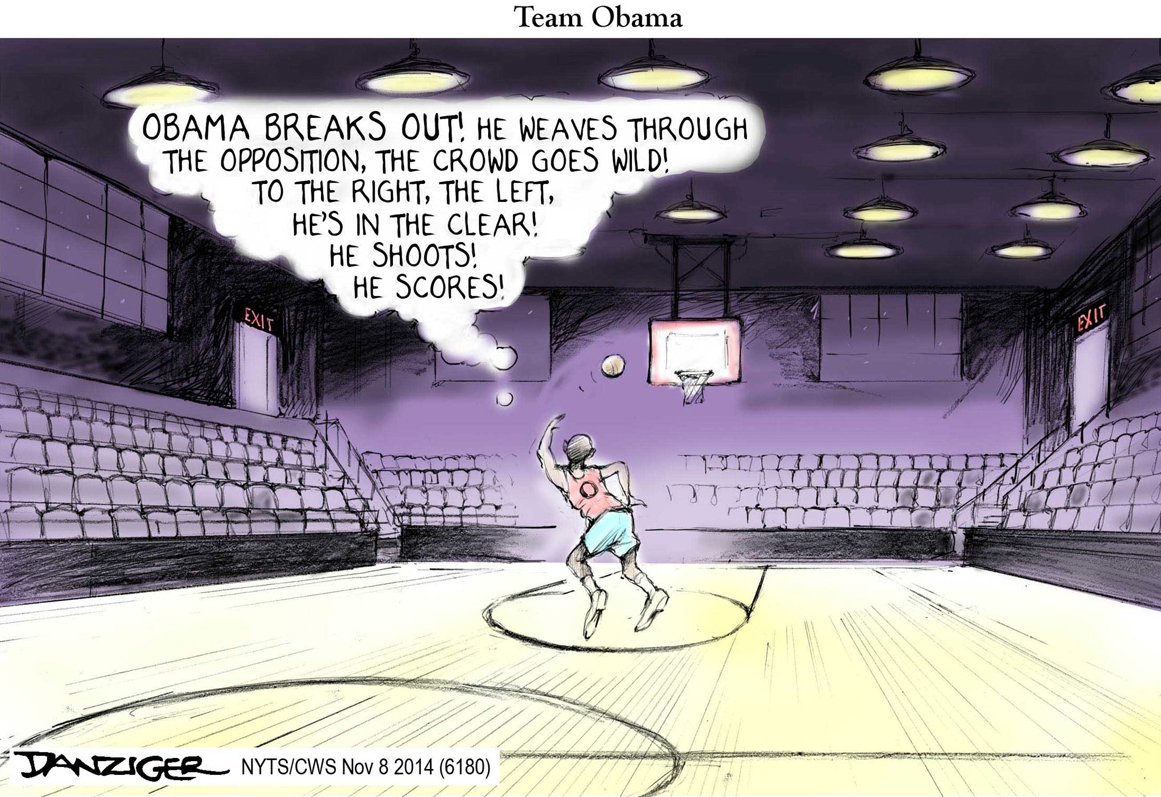
Syndicated cartoonist Jeff Danziger took aim in 2014 at President Obama’s style of governing
Jeff Danziger, a cartoonist whose work is distributed by The New York Times Syndicate and who has published 11 books of editorial cartoons, believes “American cartoonists have become victims of political correctness”—at least when it comes to hot button issues like race relations or immigration or war in the Middle East. He cites last year’s Thanksgiving cartoon by Gary Varvel in The Indianapolis Star: The family patriarch, holding a turkey on a platter, welcomes everyone by saying, “Thanks to the president’s immigration order, we’ll be having extra guests this Thanksgiving,” as three people, including a dark-mustachioed man, climb in through the window. Bloggers called the cartoon racist for its depiction of an immigrant who appeared to be Latino. The Star took down the cartoon from its site, and executive editor Jeff Taylor apologized, saying the paper “offended a wide group of readers” and erred by publishing it.
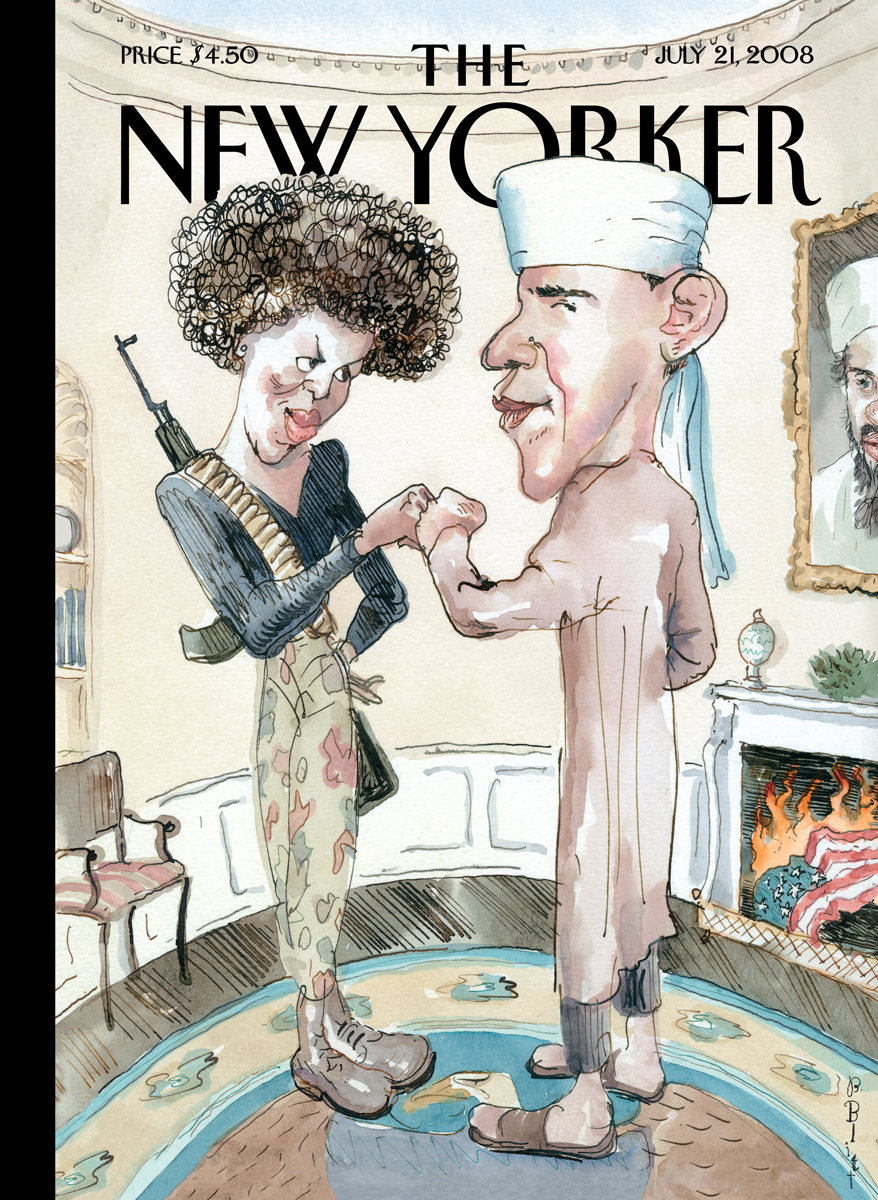
Barry Blitt’s cover for July 21, 2008 depicted innuendoes about the Obamas
Another case in point is Barry Blitt’s 2008 New Yorker cover showing Michelle Obama, outfitted as a 1970s black power radical, and Barack Obama, dressed in traditional Muslim attire, exchanging a fist bump in the Oval Office; an American flag burns in the fireplace below a framed portrait of Osama bin Laden. During the presidential campaign, political opponents depicted Obama as un-American and a secret Muslim. New Yorker art editor Françoise Mouly wanted a cover that encapsulated the tensions, and asked Blitt to give it a try. “All those innuendoes, can’t you do something with them?” she remembers asking Blitt. “All of it was being said, but just not being shown as a picture.”
Intended as a mockery of Republicans’ characterizations of the Obamas, the illustration was interpreted literally. The Obama campaign and many New Yorker readers criticized the cover. But, for Mouly, the illustration was a turning point: “It held up a mirror to what the country as a whole was doing, making visible the very dangerous insinuations and innuendos, and providing a vaccination—to take a drop of poison but put it in a place where we could all look at it and deal with it.” Says Blitt, “Finding the line and putting one foot over it … makes you reflect on your taboos and where they come from and what things we wouldn’t say and why.”
The Web may be more welcoming to political cartoons that cut closer to the bone as well as offering cartoonists the opportunity to push the form itself further. Jen Sorensen, a nationally syndicated illustrator who has also drawn for The Nation and The Austin Chronicle, heads the daily comics page on Fusion, a website geared toward millennials. The outlet publishes cartoons on issues important to young people, from unemployment to homelessness to marijuana legalization. One of Sorensen’s latest comics is a graphic novella treatment of a woman who talks about having been raped in college. “It certainly feels like I’m freer to publish probably more controversial subjects in Fusion than I would in a daily newspaper that’s trying to be very safe and non-controversial,” says Sorensen.

Jen Sorenson’s 2014 cartoon for Fusion contrasted fears about contracting Ebola with the lack of urgency around global warming
Ann Telnaes, who trained as an animator and worked for Walt Disney Imagineering, brings a digital native sensibility to her animations, illustrated GIFs, and Vine videos on The Washington Post website. And she’s upbeat about the potential for political cartooning in the digital age: “Depending on my idea, I choose the best medium for it, which is a whole different opportunity open to editorial cartoonists now.” In response to reports that Hillary Clinton used her private e-mail as secretary of state, Telnaes published a GIF of the potential presidential candidate digging her own grave; the headstone reads: “Hillary 2016.”
Last July, as Israel pounded Gaza in retribution for rocket attacks, resulting in the deaths of seven Israeli civilians and over 1,400 Palestinian civilians, according to the U.N., Telnaes produced an animation showing Israeli Prime Minister Benjamin Netanyahu punching a baby while staring at a masked militant, all of which played out against a soundtrack of staccato thuds. Telnaes received sexually violent and misogynistic e-mails in response to the cartoon.

Washington Post cartoonist Ann Telnaes commented on the post-Ferguson racial justice debate
For Christopher Weyant, political cartooning provokes such strong reactions because it has a kind of primal force, in part because of its ability to condense complex issues into simple yet potent images. “Our targets are always those who have power and especially those who are using their power unjustly,” he says. “If you’re walking on the edge of those boundaries, that’s a good place to be.”
With reporting by Jieqi Luo, Tara W. Merrigan, Laura Mitchell, Jonathan Seitz, and Eugenia WilliamsonFor the Philadelphia Daily News’s Wilkinson, the most effective political cartoons may initially provoke outrage and condemnation but ultimately promote dialogue, an exchange—in comment strands, on letters pages, at kitchen tables—through which “people actually start talking about it and both sides soften up a little bit. The cartoon isn’t the end. The cartoon is almost the beginning.”


